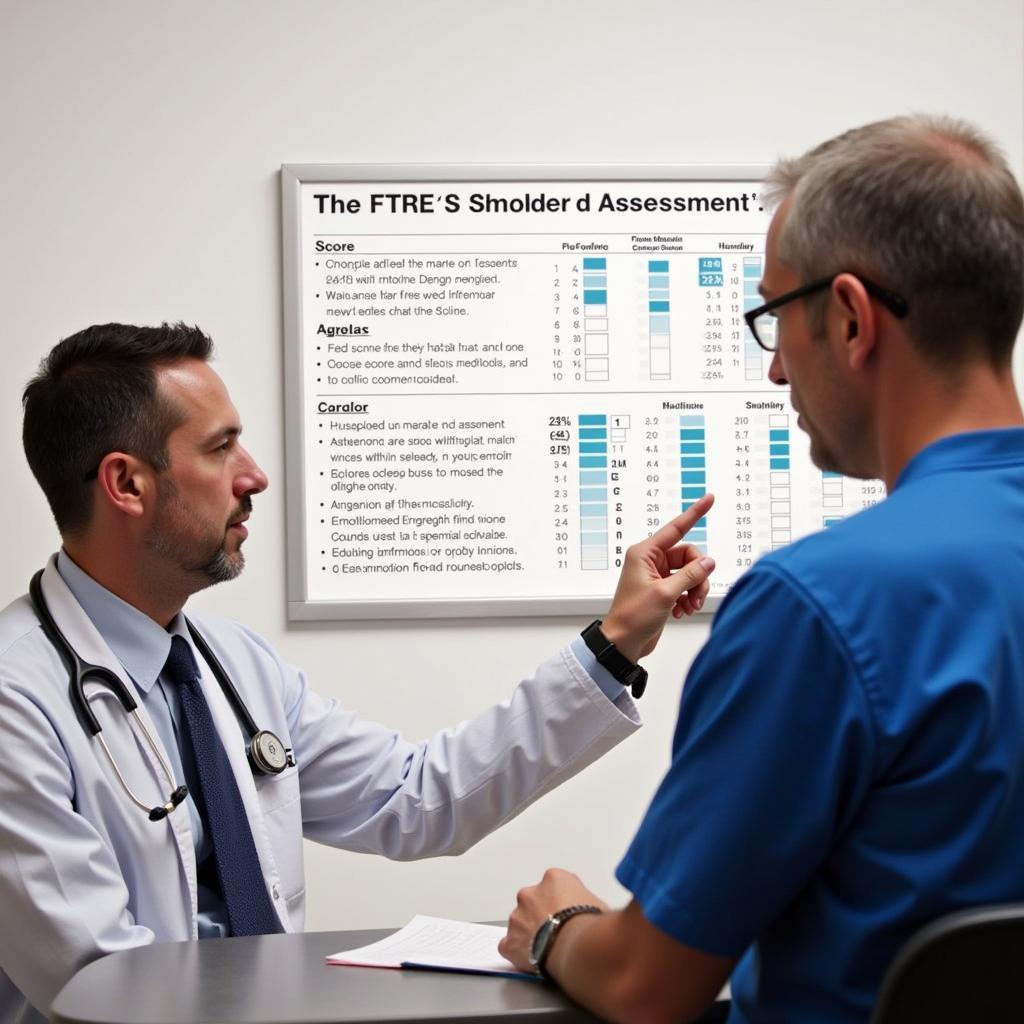The American Shoulder and Elbow Surgeons (ASES) standardized shoulder assessment is a comprehensive evaluation tool designed to assess shoulder pain and function. This widely recognized assessment helps healthcare professionals accurately diagnose and treat various shoulder conditions.
The ASES assessment employs a multi-faceted approach, combining patient-reported information with clinical observations to create a holistic picture of the individual’s shoulder health. This detailed assessment is crucial for guiding treatment decisions and tracking progress over time.
Understanding the ASES Standardized Shoulder Assessment
The ASES assessment is comprised of two main parts: a patient self-report questionnaire and a physical examination conducted by a qualified healthcare provider.
Patient Self-Report Questionnaire
This questionnaire typically consists of a series of questions addressing various aspects of shoulder pain and function, such as:
- Pain levels: Patients rate their pain intensity on a scale, typically ranging from 0 to 10, for different activities and at different times of day.
- Functional limitations: Questions focus on how shoulder pain affects daily tasks like dressing, reaching, lifting, and sleeping.
- Sports and recreational activities: This section assesses limitations in participating in sports, hobbies, and other physically demanding activities.
Physical Examination
The physical exam allows the healthcare provider to directly evaluate the shoulder’s range of motion, strength, stability, and tenderness. The examination may include:
- Visual inspection: Observing for any swelling, bruising, muscle atrophy, or postural abnormalities.
- Palpation: Feeling specific areas of the shoulder to identify points of tenderness, muscle spasm, or joint abnormalities.
- Range of motion testing: Assessing the shoulder’s ability to move in different directions, comparing it to the normal range.
- Strength testing: Evaluating the strength of the muscles surrounding the shoulder, comparing both sides for any weakness.
- Special tests: Performing specific maneuvers to assess for specific conditions such as rotator cuff tears, shoulder instability, or impingement.
Benefits of Using the ASES Standardized Shoulder Assessment
The ASES standardized shoulder assessment offers several key benefits for both patients and healthcare providers:
- Standardization: The assessment provides a consistent and structured approach to evaluating shoulder function, ensuring that different clinicians use the same criteria. This standardization enhances the reliability and accuracy of diagnoses.
- Comprehensive evaluation: By incorporating both subjective patient experiences and objective clinical findings, the assessment offers a comprehensive understanding of the individual’s shoulder condition.
- Sensitivity to change: The assessment is designed to detect even subtle changes in shoulder pain and function over time, making it a valuable tool for monitoring treatment effectiveness and tracking recovery.
- Improved communication: The standardized format facilitates clear and effective communication between healthcare providers, ensuring that everyone involved in the patient’s care has access to the same information.
Applying the ASES Assessment to Different Shoulder Conditions
The ASES standardized shoulder assessment is a versatile tool used in various shoulder conditions, including:
- Rotator cuff tears: The assessment can help identify functional limitations associated with rotator cuff tears, guiding treatment decisions such as physical therapy or surgery.
- Shoulder instability: Assessing range of motion and performing specific stability tests helps diagnose and determine the severity of shoulder instability.
- Frozen shoulder: The ASES assessment can track the limited range of motion and pain levels characteristic of frozen shoulder, helping to monitor treatment progress.
- Shoulder arthritis: The assessment helps evaluate the degree of pain and functional limitations caused by arthritis, guiding treatment options such as medication, injections, or surgery.
 Doctor Discussing ASES Results with Patient
Doctor Discussing ASES Results with Patient
The ASES Shoulder Outcome Score
The information gathered from the ASES standardized shoulder assessment contributes to the ASES shoulder outcome score. This score provides a numerical representation of the patient’s shoulder function, ranging from 0 to 100, with higher scores indicating better function.
The ASES shoulder outcome score is a valuable tool for:
- Tracking progress: Monitoring changes in the score over time helps evaluate the effectiveness of treatment interventions.
- Research purposes: The standardized score allows for comparisons of treatment outcomes across different studies and patient populations.
- Communication: The score provides a concise and objective way to communicate the patient’s functional status to other healthcare professionals.
You can learn more about the specifics of the ASES shoulder outcome score and its interpretation in our dedicated article: American Shoulder and Elbow Surgeons (ASES) Shoulder Outcome Score.
Conclusion
The American Shoulder and Elbow Surgeons (ASES) standardized shoulder assessment is an essential tool for evaluating and managing various shoulder conditions. By combining patient-reported data with objective clinical findings, this comprehensive assessment provides valuable insights into shoulder pain, function, and limitations. The ASES assessment facilitates accurate diagnosis, effective treatment planning, and ongoing monitoring of patient progress, ultimately contributing to improved outcomes and enhanced shoulder health.
Frequently Asked Questions (FAQ)
1. How long does the ASES standardized shoulder assessment take?
The assessment typically takes about 15-20 minutes to complete, including both the questionnaire and physical examination.
2. Who can administer the ASES assessment?
The assessment is typically administered by qualified healthcare professionals such as orthopedic surgeons, physical therapists, or physician assistants specializing in shoulder care.
3. Is the ASES assessment covered by insurance?
Insurance coverage for the assessment varies depending on individual plans. It’s best to check with your insurance provider to confirm coverage.
4. Can I complete the ASES assessment online?
While some versions of the patient self-report questionnaire may be available online, it’s crucial to have the assessment administered and interpreted by a qualified healthcare professional for accurate diagnosis and treatment planning.
5. How often should I repeat the ASES assessment?
The frequency of reassessment depends on the specific shoulder condition and treatment plan. Your healthcare provider will determine the appropriate schedule for follow-up assessments to monitor progress.


